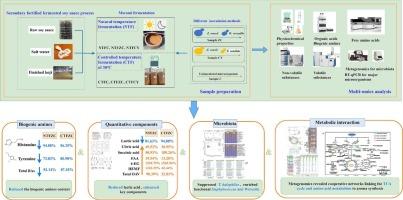Temperature-driven functional microbial interactions in soy sauce fermentation: Effects of Zygosaccharomyces rouxii and Wickerhamiella versatilis on flavor enrichment and biogenic amine reduction
IF 5.2
1区 农林科学
Q1 FOOD SCIENCE & TECHNOLOGY
International journal of food microbiology
Pub Date : 2025-08-19
DOI:10.1016/j.ijfoodmicro.2025.111399
引用次数: 0
Abstract
This study elucidates the temperature-dependent interactions between halotolerant yeasts and microbial communities during secondary fortified soy sauce fermentation (SFFSS) and their implications for flavor enhancement and safety. A dual-mode fermentation system compared natural temperature fermentation (NTF) and controlled temperature fermentation (CTF, 30 °C), each with and without co-inoculation of Zygosaccharomyces rouxii and Wickerhamiella versatilis (ZC). Multi-omics analyses integrating amplicon sequencing, metagenomics, and metabolomics revealed that CTF control elevated amino acid nitrogen and aroma compounds, while increasing biogenic amines (BA) by 47.88 %. In both NTF and CTF modes, the ZC pattern significantly reduced lactic acid while enhancing succinic acid, umami/sweet free amino acids, and key aroma compounds (e.g., 4-ethylguaiacol, 5-ethyl-4-hydroxy-2-methyl-3(2H)-furanone), alongside enriching functional bacteria (Staphylococcus, Weissella), stabilizing fungal communities, and suppressing Tetragenococcus and Ligilactobacillus pobuzihii. Mechanistically, ZC pattern promoted tricarboxylic acid cycle flux and amino acid metabolism, synergistically enhancing volatile phenolics, esters, and alcohols, and reduced BA by >87 % via dual modulation of decarboxylase inhibition and oxidase activation. Network analyses linked microbial composition shifts to targeted flavor metabolite synthesis, providing a mechanistic framework for microbial community engineering. These findings highlight yeast-mediated, temperature-driven modulation of microbiota–metabolite networks as a viable strategy for producing high-quality, safe soy sauce with optimized flavor complexity.

酱油发酵中温度驱动的功能性微生物相互作用:rouxizygosaccharomyces rouxii和Wickerhamiella multilis对风味富集和生物胺还原的影响
本研究阐明了耐盐酵母和微生物群落在二次强化酱油发酵(SFFSS)过程中的温度依赖性相互作用及其对风味增强和安全性的影响。采用双模式发酵系统,比较了分别接种和不接种rouxii酵母菌和多面Wickerhamiella (ZC)的自然温度发酵(NTF)和控制温度发酵(CTF, 30°C)。整合扩增子测序、宏基因组学和代谢组学的多组学分析显示,CTF控制氨基酸氮和芳香化合物的升高,同时增加了47.88%的生物胺(BA)。在NTF和CTF模式下,ZC模式显著减少了乳酸,同时增强了琥珀酸、鲜味/甜味游离氨基酸和关键香气化合物(如4-乙基愈木酚、5-乙基-4-羟基-2-甲基-3(2H)-呋喃酮),同时丰富了功能细菌(葡萄球菌、韦塞拉菌),稳定了真菌群落,抑制了四烯球菌和波氏杆菌。从机制上看,ZC模式促进了三羧酸循环通量和氨基酸代谢,协同增强了挥发性酚类、酯类和醇类,并通过脱羧酶抑制和氧化酶激活的双重调节使BA降低了87%。网络分析将微生物组成变化与目标风味代谢物合成联系起来,为微生物群落工程提供了机制框架。这些发现强调了酵母介导的、温度驱动的微生物代谢物网络调节是一种可行的策略,可以生产出具有优化风味复杂性的高质量、安全的酱油。
本文章由计算机程序翻译,如有差异,请以英文原文为准。
求助全文
约1分钟内获得全文
求助全文
来源期刊
CiteScore
10.40
自引率
5.60%
发文量
322
审稿时长
65 days
期刊介绍:
The International Journal of Food Microbiology publishes papers dealing with all aspects of food microbiology. Articles must present information that is novel, has high impact and interest, and is of high scientific quality. They should provide scientific or technological advancement in the specific field of interest of the journal and enhance its strong international reputation. Preliminary or confirmatory results as well as contributions not strictly related to food microbiology will not be considered for publication.

 求助内容:
求助内容: 应助结果提醒方式:
应助结果提醒方式:


